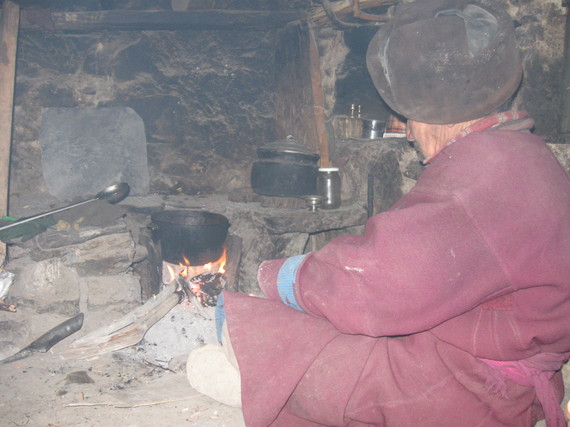In his watershed encyclical released last week, Pope Francis describes the two defining issues of our time -- climate change and poverty -- as essentially linked: "[A] true ecological approach ... must integrate questions of justice in debates on the environment, so as to hear both the cry of the earth and the cry of the poor."
The Pope has quite rightly framed reducing the pollution that causes global warming as a moral imperative. The impacts of climate change are already hitting the poorest the hardest, and the damage will only multiply as time goes on. Reducing emissions of carbon dioxide and other greenhouse gases today will surely save and improve countless future lives.
But there is one warming pollutant that affects the poor more than any other, right now, all over the world. It also happens to be the only tool in our kit for slowing down atmospheric warming immediately. It's called black carbon, and it might be the most dangerous pollutant you've never heard of.
Black carbon is made up of ultrafine particles produced by the inefficient combustion of all kinds of fuels, from wood to diesel to kerosene. It's basically the stuff that makes soot dark. (It's also the source of a candle's bright flame -- the light it throws is simply black carbon particles heated to the point of incandescence.)
Scientists call it black carbon because it is incredibly efficient at absorbing light and turning it into heat. You might be surprised to learn that this property makes black carbon the second biggest contributor to climate change after carbon dioxide.
These particles streams out of countless stovepipes and vehicle tailpipes and coal boiler smokestacks around the world, up into the atmosphere -- imagine millions of tiny little black rocks suspended in the sky. We all know that darker-colored objects become warmer in sunlight than lighter-colored objects. Black carbon does the same thing at a microscopic scale, ratcheting up temperatures wherever it's present.
To understand how black carbon wreaks a special form of climate havoc -- one that threatens the poor in particular -- we need only focus our lens on South Asia, the region home to more people living in extreme poverty than any other.
When it lands on the surface of glaciers in the Himalaya, black reduces the light they reflect back to space and accelerates their melting, disrupting the future flow of the Ganges, Indus, Brahmaputra and other major rivers on which hundreds of million depend. By changing the temperature profile of the air circulating over South Asia, it disrupts the monsoon on which 1.5 billion people depend for seasonal irrigation. By hastening the loss of the Greenland ice sheet (through the same change in reflectivity as in the Himalaya), it contributes to the ongoing sea level rise that by 2070 could expose 37 million people in just three coastal South Asian cities -- Calcutta, Mumbai and Dhaka -- to chronic, dangerous flooding. And by reducing the amount of sunlight reaching crops, black carbon (along with damaging ground-level ozone pollution) reduces India's rice and wheat yields by almost half each year.
This is quite a rap sheet, but the tally of black carbon's damage on the poor gets much worse, and much more intimate. Almost three billion people around the world still cook with wood, dung or other solid fuels in simple hearths and stoves because they lack access to modern fuels and technology. This inefficient way of cooking produces insane amounts of smoke in kitchens from Nepal to China to Kenya. For a woman in rural India cooking in her family, tending a wood fire in a simple mud stove means she has the equivalent of a two-pack-a-day cigarette habit, even though she's never smoked a day in her life.
The Pope is aware of the unbelievable damage this causes. "Exposure to atmospheric pollutants produces a broad spectrum of health hazards," he writes in Laudato Si, "especially for the poor, and causes millions of premature deaths. People take sick, for example, from breathing high levels of smoke from fuels used in cooking or heating."
Indeed, exposure to this household air pollution is the single greatest environmental health risk factor worldwide, and the number one killer of women and girls in South Asia. Worldwide, it cuts short the lives of 4.3 million people every year, more than the combined toll from malaria, HIV/AIDS and tuberculosis. Ultrafine particles like black carbon are a major component (and possibly the most dangerous part) of this toxic airborne stew.
Now there are many reasons why so much of the world still cooks this way, but the primary one is quite simple: because they are poor, and don't have affordable alternatives.
Any credible effort to fight climate change in a way that lifts the fortunes of the poor must include an aggressive, coordinated global effort to reduce this energy poverty, which keeps 1.2 billion people in the dark -- cooking with dung and wood, lighting with kerosene (which produces 99 percent black carbon emissions) and breathing intolerable levels of smoke. It must also address the outdoor air pollution, from industrial sources and rapidly growing vehicle fleets in the cities of the developing world, that kills another 3.5 million people each year.
"The effects of the present imbalance can only be reduced by our decisive action, here and now," the Pope writes. Sharply reducing carbon dioxide emissions remains the paramount concern for the long-term welfare of humanity, both rich and poor alike. But the benefits of that action won't manifest for decades to come. To slow down warming in the near-term, and save the lives of millions living today, we should also set our sights on soot.
Unlike other warming pollutants, black carbon only lasts a very short time in the atmosphere -- about a week or two. This means that if we reduce emissions of black carbon, we see immediate benefits. The skies will clear quickly, and hundreds of millions will breathe much easier. "We require a new and universal solidarity," the Pope urges. Seeing the soot that surrounds us, from the Bronx to Beijing, can help us forge that solidarity.
As Macarthur "genius" fellow and black carbon expert Tami Bond told me, in the course of researching my new book about our global soot problem and its solutions, "The nice thing about the black carbon question is that it's forced people to look at the lowest (economic) levels of society and say, all this stuff we've been doing hasn't touched a major issue."
And once we look, we can discern hope in black carbon's dark story. The great 19th century scientist Michael Faraday once observed of the soot streaming out of a candle's flame, "Is it not beautiful to think that such a process is going on, and that such a dirty thing as charcoal can become so incandescent?"
Black carbon is thus a glowing paradox: it's a tracer that helps us read the hidden connections between climate and poverty, and between everyone on this planet who cooks and breathes. Our new understanding of the extent of black carbon's damage to human health, to the environment and to the climate is sobering -- but it is also a cause for hope. It thus shines a light on a path forward, one that leads us away from climate chaos, and toward brighter prospects for those living in poverty.

